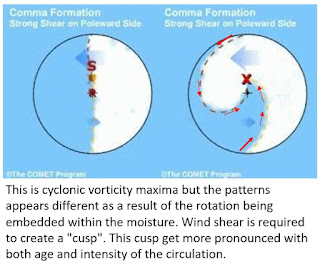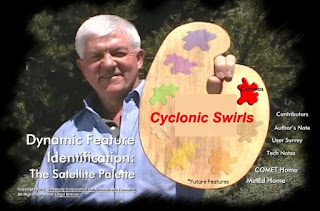| #1714 "White Pine Island" Pixels Link |
No, this is not about the Rain Dance. That is coming in a future Blog. This is all about looking at the weather in a creative and artistic way. With the fundamentals of the previous posts, you may never look at the sky in the same way ever again... and that is a good thing.
The conveyor belt conceptual model of the wind patterns found with a mid latitude low pressure area, is fundamental to the understanding of cloud configurations. Note that the shorter term “cyclone” is frequently used to replace “low pressure area”. The idealized conveyor belts are best examined in the atmospheric frame of reference relative to the low. The atmospheric frame of reference was described in the first blog “Cloud Shapes and Lines in the Atmosphere”.
 |
| The Conveyor Belt Conceptual Model |
For example, the relative flow of the blue CCB is typically opposite to the normal west to east motion of the cyclone. The motion of the low can thus counter the atmospheric frame motion of the CCB. In the case when the CCB is exactly equal and opposite to the motion of the low, the earth surface winds produced under the CCB must be calm – the so-called “calm before the storm”. If the actual surface winds are westerly then the low is moving faster than the CCB winds and the storm will soon pass. If the surface winds are easterly then the low is moving slower than the CCB winds. Be prepared for a longer duration and significant cyclone. The observation of the surface winds resulting from the sum of the CCB winds and the translation of the cyclone can tell you a lot about the storm. I will describe this further in a coming blog.
Curling the fingers of your right hand in the direction of the flow at the head of each of these three conveyor belts, will point your thumb either up or down. An upward pointing thumb locates what meteorologists refer to as a positive swirl or vorticity maximum. A downward pointing thumb locates a negative swirl or vorticity minimum. Remember that these companion swirls are linked and part of the same giant smoke ring in the sky. See “The Theory of Unified Swirls”. Bob Dylan knew that the answer was indeed blowing in the wind. You can imagine the deformation zones at the leading edge of each of these conveyor belts. See “A Closer Look at Lines in the Sky”.
Now imagine all of this in three dimensions and mentally project the deformation zones on to the earth. You will find that the warm conveyor belt (WCB) slopes down to the warm front. The dry conveyor belt (DCB) and the cold conveyor belt (CCB) combine and project on the surface cold front. (I had to retire before all of the graphics and animations showing how the CCB and DCB might interact were completed with my friends at COMET.) In any event, fronts are the leading edges of the conveyor belts! Fronts are deformation zones!
Jacob Bjerknes and his father, Vilhelm Bjerknes, both giants in the world of meteorology, developed the Norwegian cyclone model to explain the generation, intensification and ultimate decay of mid-latitude cyclones. The life cycle of cyclones typically follow similar stages and understanding those steps certainly aid in weather prediction. Their tremendous research was completed during the years of the First World War. They used the word “front” to describe the sharply defined boundaries between air masses. The military terminology was totally understandable.
 |
| Vilhem_Bjerknes and baby Jacob |
 |
| Jacob Bjerknes |
Our knowledge of air flows has increased in the last century and it might be a fine time to put a more artistic spin on this science. Weather can be more of a ballet than a battle. Every swirl and every line in the sky can be understood and appreciated for both the exquisiteness of the form and the beauty of the science that they reveal.
 |
| Not a monster... ol' Frank and Fred and both art and science, can and should be your friend |
Warmest regards,
Phil the Forecaster
PS: Much more to come.























